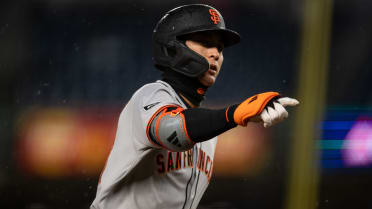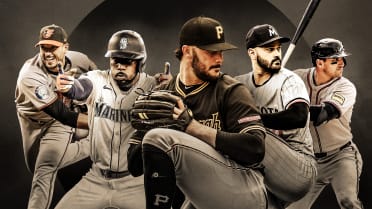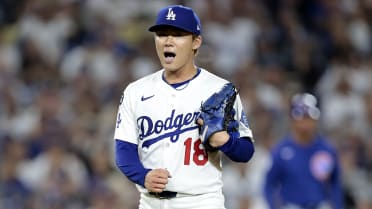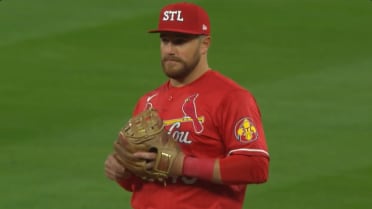We’ve been talking about this winter’s incredible crop of free-agent shortstops for quite some time, and it’s finally here. Even without Francisco Lindor, who signed a $341 million extension with the Mets before the 2021 season, we still have Carlos Correa, Corey Seager, Javier Báez, Trevor Story and Marcus Semien -- “The Big Five” -- and a handful of lesser or multi-positional types behind them.
That’s five very talented players who come in very different shapes, sizes, ages and talent sets. (More than five, really, but because Chris Taylor is valued in part because he can play multiple spots and is unlikely to be anyone's regular shortstop, we'll exclude him here.) How do they differ, and which one fits your team best? It might depend on what you want.
1) Who is … the youngest?
Here’s how old The Big Five will be on Opening Day 2022.
27 -- Correa, Seager
29 -- Story, Báez
31 -- Semien
This matters more than you think it does; baseball’s stars have been trending younger for years, and it’s how players like Manny Machado get 10-year deals, because they reach the market in their mid-20s. At FanGraphs, for example, their readership has estimated that Correa and Seager will get deals in the seven-to-eight-year range, Story five-to-six years, and Semien and Báez four years.
Correa is five months younger than Seager and made his debut three months sooner in 2015; there’s no real meaningful difference between them here, but they each hold a nice advantage within this group. Story and Báez were born two weeks apart in the fall of 1992. Semien is the outlier here, as he will turn 32 late in the 2022 season; he made his debut long enough ago that Derek Jeter, Alex Rodriguez and Ichiro Suzuki were in the opposing lineup that day.
So you might think that teams will lean towards the younger players, and they will for longer contracts, except that …
2) Who has … stayed the healthiest?
… we’re about to flip that list on its head.
Over the last four seasons, the games played leaderboard looks like this.
536 -- Semien
503 -- Story
495 -- Báez
391 -- Correa
307 -- Seager
Seager missed most of 2018 due to Tommy John surgery, and he’s missed smaller spans of time since with injuries to his left hamstring and a fractured right hand. Correa fractured his rib in 2019 and missed time in both 2017 and ‘19 with back trouble, though he was able to stay healthy in 2021; he actually played the second-most games across 2020-’21 in this group, behind only the durable Semien. Story missed brief amounts of time with thumb and shoulder issues.
This all throws a bit of a wrench into things, because Seager’s injuries (primarily the Tommy John, but also breaking his hand while being hit by a pitch) are somewhat fluky. Meanwhile, Correa’s back issues are concerning at a young age, yet they haven’t popped up for two years. Meanwhile, only three players have played more games than Semien over the last four seasons, but he is the oldest.
3) Who is … the best defender?
This is actually a trick question, because the answer is “none of them are,” at least if we’re looking past just The Big Five.
How is that possible? Because the free-agent shortstop who just piled up the most value on defense, per Statcast’s Outs Above Average, is actually Andrelton Simmons, who has been one of the most elite defenders in the game for a decade now. Of course, Simmons has a 71 OPS+ and 10 homers over the last three seasons combined, making him a one-year fallback option at best for those who miss out on one of the top five.
Setting him aside, the 2021 Outs Above Average list for our five looks like this:
12 -- Correa
5 -- Semien
3 -- Báez
-5 -- Seager
-7 -- Story
But a whole lot of context is required here. Let’s start with the big two, because they’re easy. Correa has long been an excellent defender; since 2018, he’s tied with Simmons as the third-best defensive shortstop, at +49 OAA. Seager has long been competent but unspectacular, with a likely move to third base coming at some point; since 2018, he’s posted a minus-3 OAA, or slightly below average.
It’s more complicated with the other three.
Semien moved to second base for Toronto in 2021 and played well enough there to win a Gold Glove. He still got into 21 games at short, and the numbers reflected the eye test, as he was +7 OAA at second, and -2 at short. Over the last four seasons, he’s been -13 at short, which might just make “keep him at second base” the best path forward anyway.
Báez, meanwhile, has for years been an elite and exciting defender, with a caveat. Since 2018, he’s been the third-most valuable fielder (catchers being excluded here), behind Nick Ahmed and Lindor, combining his time at second, short and third. But there’s at least some evidence that he’s coming back closer to the pack, because after 2019’s monstrous +32 OAA, he was +9 in the shortened 2020 and +3 in 2021. It’s not A Problem, so much as A Thing To Keep An Eye On.
And Story? In 2019, he was a top-five shortstop defensively. From 2016-’20 he was in the top 10. But in 2021, he fell to -7. (Defensive Runs Saved, for what it’s worth, still considered him to be solid.) It might be a single-year fluke, though it’s worth noting he injured his elbow in late May, and there was a clear decline in his throwing strength afterwards.
4) Who was … the best hitter?
This is the easiest to see, because hitting is the easiest skill to evaluate. This is what 2021 looked like.
145 OPS+ -- Seager
133 OPS+ -- Semien
131 OPS+ -- Correa
117 OPS+ -- Báez
103 OPS+ -- Story
That represents a down year for Story, who had posted a 123 OPS+ mark from 2018-’20. (Let’s break here to point out that while he does have large home/road splits, as most Rockies hitters do, the recent success of Nolan Arenado and DJ LeMahieu should prove that good Colorado hitters are more than just their road splits.)
Looking at the more advanced Statcast numbers, which focus on quality of contact (as well as strikeouts+walks) more than outcomes, Seager was at the top of the list and Báez at the bottom. Interestingly, Semien’s massive year looks more good than great by this view, suggesting perhaps in part that the pair of extremely hitter-friendly parks the Jays played in before getting to Toronto helped boost his line. In Dunedin, he had a .914 OPS; in Buffalo, a .933 OPS; in Toronto, an .801 mark.
Though much was made of Semien’s down 2020 in between two excellent seasons, Báez has had a wild few years himself. In 2019, he had a 115 OPS+; in 2020, he had a miserable 59 OPS+; in 2021, he had a relatively unimpressive .242/.287/.474 line through Sept. 2 before a red-hot final few weeks boosted his season numbers.
It’s similar, though not identical, if you expand the OPS+ list to the past three seasons.
131 OPS+ -- Seager
130 OPS+ -- Semien
126 OPS+ -- Correa
114 OPS+ -- Story
113 OPS+ -- Báez
This time, the Statcast metrics rank it as: Seager, Correa, [big gap], Story, Semien and Báez.
Depending on how you want to view it, there's either a Big Two here (Seager and Correa) or a Big Three (with Semien joining them), and then Story/Báez likely as the final two.
It’s worth noting, as well, that this aligns pretty well to strikeout rate, where Correa and Seager are better than average, Semien roughly average, Story a little worse than average and Báez’s 34% strikeout rate in 2021 one of the highest marks in the game.
When we talk about whether strikeout rate matters as much as people want it to for hitters, we generally mean it in the sense that all contact isn’t good contact, because turning a strikeout into a weak groundout isn’t really adding value, and you can live with strikeouts from bats like Aaron Judge or Giancarlo Stanton because the quality of contact they make is so, so good. But in this case, with all five players having good power and excellent quality of contact, the more of it they can make, the better.
5) Who did the best … against elite fastball velocity?
This is not more important than overall offensive performance, but in lieu of direct bat speed tracking, which we don’t currently have, seeing who is performing against high velocity can be a good proxy for bat speed, and that’s a great indicator of exit velocity. If you find yourself needing to cheat to catch up to velocity, that may leave you vulnerable against breaking and offspeed pitches.
To that end, let’s check into what these hitters did against all pitches 95 mph or harder. If we start with swing and miss from 2021 against 95+, here’s a big point in Semien’s favor. The Major League average, for context, was 23.5%.
16.2% -- Semien
18.7% -- Correa
25.3% -- Seager
27.3% -- Story
40.5% -- Báez
The ranking is unchanged over the last three years, and there’s a decent amount of year-to-year consistency for Correa, Semien and Story, though Seager and especially Báez took a big step back in 2021. Again, Semien, Correa and Seager are the top three, with Story and Báez somewhat behind.
What about production against velocity over the last three years? OPS isn’t really a perfect metric for this, as it’s not park-adjusted and we do have a Rockie, but it’s easily understandable and it tells a story here.
1.016 OPS -- Semien
.875 OPS -- Seager
.810 OPS -- Story
.711 OPS -- Correa
.653 OPS -- Báez
By a more advanced metric, of the 261 hitters with at least 100 plate appearances ending with pitches 95 mph or harder over the last three years, Semien was 10th best in baseball. Story was 66th, Seager was 82nd, Correa was 115th and Báez was 252nd, or 10th from the bottom.
6) Who has … the best running speed?
This doesn’t matter that much compared to the more important aspects of their games, though it’s worth noting that Semien, Story and Báez each stole between 15-20 bases this past year, while Correa and Seager combined for one. For those first three, part of their value is what they add on the bases.
Looking at Statcast’s Sprint Speed, which sets 27 ft/sec as ‘average,’ there’s a pretty clear gap between the three older players -- consider it a three-way tie at the top -- and the two youngest, just not in the way you might think.
28.7 ft/sec -- Story
28.6 ft/sec -- Báez, Semien
26.9 ft/sec -- Correa
26.5 ft/sec -- Seager
It would be more interesting if there were trends here, reasons to wonder about the future for anyone or any underlying health stories, as we’ve been able to find in the past. Story has been consistently in the 90th percentile or better of all runners, even if 2021 was his lowest mark. Báez and Semien are consistently around the 80th percentile of speed.
Correa, however, took a big step back, because he was near the 80th percentile in 2015-’16, around the 65th percentile for the four years after that, and fell down to the 48th percentile in ‘21, or slightly below average. Seager, too, fell to a career-low 39th percentile (if you set aside the 2018 season he barely played). They’re also the two best players here, so this might not be as important as you’d think it should be.
7) Who has … the best 2022 projections?
This is what it really all comes down to, right? While obviously these players are all getting long-term deals if they choose to, we can at least look at what the 2022 projections say, courtesy of Steamer.
5.1 WAR -- Correa
4.5 WAR -- Seager
4.4 WAR -- Semien
3.6 WAR -- Story
2.0 WAR -- Báez
As we get further into the winter, other projection systems will come out with their numbers, and while you can quibble with the exact numbers there -- we think this is a little low on Báez -- the general ranks seem about right to us.
After all, Correa is the best combination of youth, offense and fielding. Seager’s bat can match up to Correa’s but his fielding cannot, putting him slightly behind. Semien has the recent track record to match, but he’s four years older, which projections account for, and he might not be a shortstop. Story and Báez have clear strengths but perhaps more questions, though being at the end of this group is hardly an insult when you realize who the top three are.
Ultimately, there’s not really a wrong answer here, at least in the sense that if you need a shortstop and want a shortstop, you will have no problem finding one. Even without Lindor, this is an incredibly good, deep and talented class.
Mike Petriello is a stats analyst for MLB.com, focusing on Statcast and Baseball Savant, and is also a contributor to MLB Network.




